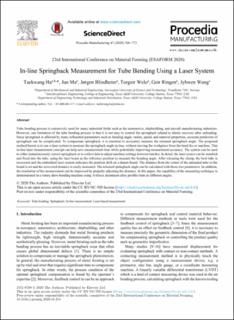| dc.contributor.author | Ha, Taekwang | |
| dc.contributor.author | Ma, Jun | |
| dc.contributor.author | Blindheim, Jørgen | |
| dc.contributor.author | Welo, Torgeir | |
| dc.contributor.author | Ringen, Geir | |
| dc.contributor.author | Wang, Jyhwen | |
| dc.date.accessioned | 2020-05-20T12:41:44Z | |
| dc.date.available | 2020-05-20T12:41:44Z | |
| dc.date.created | 2020-05-07T12:10:25Z | |
| dc.date.issued | 2020 | |
| dc.identifier.citation | Procedia Manufacturing. 2020, 47 766-773. | en_US |
| dc.identifier.issn | 2351-9789 | |
| dc.identifier.uri | https://hdl.handle.net/11250/2655197 | |
| dc.description.abstract | Tube bending process is extensively used for many industrial fields such as the automotive, shipbuilding, and aircraft manufacturing industries. However, one limitation of the tube bending process is that it is not easy to control the springback related to elastic recovery after unloading. Since springback is affected by many influential parameters such as bending angle, radius, speed, and material properties, accurate prediction of springback can be complicated. To compensate springback, it is essential to accurately measure the released springback angle. The proposed method herein is to use a laser system to measure the springback angle in-line, without moving the workpiece from the bend die or machine. This in-line laser measurement concept can help save measurement time while potentially improving measurement accuracy. The system can be used to either instantaneously correct springback or to collect data to adjust machine settings between batches. In detail, the laser source can be installed and fixed into the tube, using the laser beam as the reference position to measure the bending angle. After releasing the clamp, the bent tube is recovered and the embedded laser system indicates the position shift on a datum board. The distance from the center of the unloaded tube to the board is set and the recovered distance is easily measured. The released springback angle can be calculated with those two parameters. In addition, the resolution of the measurement can be improved by properly adjusting the distance. In this paper, the capability of the measuring technique is demonstrated in a rotary draw bending machine using AA6xxx aluminum alloy profiles bent at different angles. | en_US |
| dc.language.iso | eng | en_US |
| dc.publisher | Elsevier | en_US |
| dc.rights | Attribution-NonCommercial-NoDerivatives 4.0 Internasjonal | * |
| dc.rights.uri | http://creativecommons.org/licenses/by-nc-nd/4.0/deed.no | * |
| dc.title | In-line Springback Measurement for Tube Bending Using a Laser System | en_US |
| dc.type | Peer reviewed | en_US |
| dc.type | Journal article | en_US |
| dc.description.version | publishedVersion | en_US |
| dc.source.pagenumber | 766-773 | en_US |
| dc.source.volume | 47 | en_US |
| dc.source.journal | Procedia Manufacturing | en_US |
| dc.identifier.doi | 10.1016/j.promfg.2020.04.233 | |
| dc.identifier.cristin | 1809773 | |
| dc.description.localcode | © 2020 The Authors. Published by Elsevier Ltd. This is an open access article under the CC BY-NC-ND license (https://creativecommons.org/licenses/by-nc-nd/4.0/) | en_US |
| cristin.ispublished | true | |
| cristin.fulltext | original | |
| cristin.qualitycode | 1 | |

